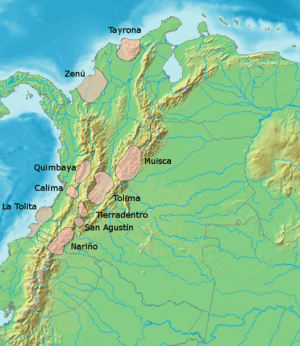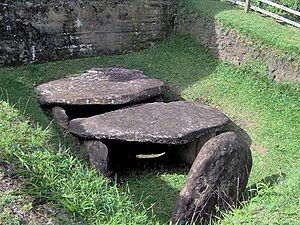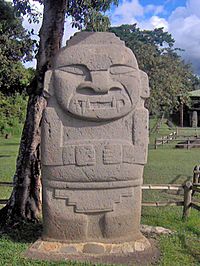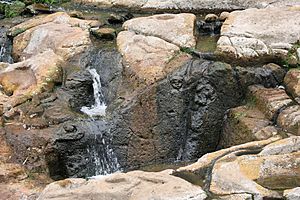San Agustín culture facts for kids
The San Agustín culture was one of the oldest groups of people in Colombia before Christopher Columbus arrived. This culture started a very long time ago, at least 6,000 years ago! People from this culture created hundreds of huge stone sculptures.
Scientists are still studying how this culture began and what it was like. For its time, the San Agustín culture was very advanced in farming, making pottery, working with gold, and creating amazing sculptures. You can find most of their ancient sites in the San Agustín Archaeological Park and the Parque Arqueológico Nacional de Tierradentro.
Contents
- When Did the San Agustín Culture Live?
- How Was the Culture Discovered?
- Where Was the San Agustín Culture Located?
- What Did Archaeologists Find?
- How Did They Live?
- How Was Their Society Organized?
- Amazing Stone Sculptures
- The Mesitas Area
- What Did They Wear and Use for Jewelry?
- What Was Their Pottery Like?
- See also
When Did the San Agustín Culture Live?
The San Agustín culture began around 3300 BCE. Scientists know this from studying old sites like Lavapatas.
The history of the San Agustín culture is split into different time periods:
- Archaic Period: This was the earliest time.
- Formative Period: People started settling down.
- Regional Classic Period: From 1 AD to 900 AD. This was a very important time for the culture.
- Recent Period: From 900 AD to 1350 AD.
During the Archaic period, people in this area were small groups of 15-25 individuals. They moved around often and gathered wild plants for food. They made tools from stone, bone, and shells.
The Formative Period started around 1000-600 BC. People began to settle in one place, especially near good farming land. They started making pottery and growing crops like corn, beans, and potatoes. They buried their dead in special tombs near their homes.
In the Regional Classic Period (1-900 AD), the San Agustín people built large earth mounds. These mounds covered tombs made with big stone slabs. Stone statues of mythical creatures often marked these tombs. Even though the tombs were grand, they usually had few items buried with the dead. The pottery from this time was simple, but the gold items were very detailed and skillfully made.
The Recent Period (900-1350 AD) saw the population grow even more. They built complex systems of drainage channels and earthworks, showing that farming became even more important.
The San Agustín culture was at its peak from about 800 BC to 1 BC. The people who built these amazing stone monuments left the area by the 14th or 15th century AD. No one is quite sure why they left. The nearby Tierradentro culture is thought to be connected to the San Agustín culture.
How Was the Culture Discovered?
The first written information about the ancient ruins of San Agustín came from a missionary named Fray Juan de Santa Gertrudis. He visited the area many times in 1756. His travel diary, which described his journey from Cartagena de Indias to Lima, was not published until 1956.
Where Was the San Agustín Culture Located?
This ancient culture was located in a mountainous area in southern Colombia, at the base of the Colombian Massif. The land there has rolling hills and slopes that lead down into narrow, deep canyons. Because of this varied landscape, the San Agustín area has many different climates.
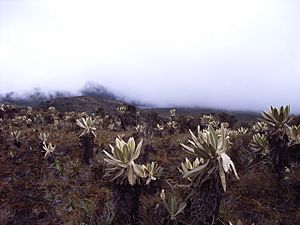
The ancient sites are found in what are now the towns of San Agustín, Isnos, and Saladoblanco in the Huila Department.
What Did Archaeologists Find?
Archaeologists have found statues and tombs in special ceremonial areas, often separated from each other. These places have names like Mesitas, Lavapatas, Alto de los Ídolos, and La Chaquira.
Some tombs are lined with large stone slabs and contain stone coffins. These are covered by artificial mounds that can be up to 30 meters (about 98 feet) wide and 5 meters (about 16 feet) tall. Other tombs have statues that are over 4 meters (about 13 feet) tall and weigh many tons.
One of the most amazing stone carvings is called "Fuente de Lavapatas" (Lavapatas Fountain). It's carved into the rocky bed of a stream. It has three pools and many carved figures of snakes and frogs. Tiny channels allow water to flow through it. It's believed this place was used to worship water gods and for healing ceremonies.
Alto de los Ídolos
Alto de los Ídolos is located in the town of Isnos. It's a site with many tombs, mounds, and statues. It was first described by Konrad Preuss in 1931. It's about 4 kilometers (2.5 miles) southwest of Isnos.
Similar settlements to the San Agustín culture have been found deep in the Amazon jungle, about 100 miles southwest of San Agustín. Much of this area is still unexplored, especially the parts that go up towards el Valle de Las Papas, which is covered by thick jungle.
How Did They Live?
Archaeologists have learned a lot about how people lived in the upper Magdalena River area. It's thought they farmed corn, peanuts, chontaduro (a type of palm fruit), and cassava. They also fished and hunted. Evidence of these activities has been found in layers of earth dating back to the 7th century BCE.
Their amazing stone sculptures, which show their beliefs about the world and religion, are very different from their simple homes. Their houses were round and had straw roofs. They were built with materials that would break down over time, so not much is left of them, except for holes in the ground where wooden posts once stood. These posts formed walls and supported the roofs, creating enclosures up to 9 meters (about 30 feet) wide.
A settlement usually had several huts close together. They had stoves made of rounded stones. Traces of small workshops and waste piles have been found inside or near the houses. The landscape of the region, with its gentle hills and many streams, meant that settlements were spread out, much like rural areas in Colombia today.
How Was Their Society Organized?
When the San Agustín culture was at its strongest, it was known for its stone statues. They also built large earth mounds or terraces for their burial grounds, and retaining walls. Their tombs were covered with big stone slabs or artificial mounds topped with small shrines. They even carved ceremonial fountains into natural rock.
All these things suggest that their society was well-organized with different levels of people. The sculptures, especially, show that there were skilled artists who specialized in this work. Differences in the tombs at the same site, without clear signs of different time periods, also suggest that society was divided into groups. This could have been based on different jobs or a strong religious and political leadership, forming small chiefdoms. This was a common way for many native groups in the Andes to be organized when the Spanish arrived in the 16th century.
It's possible that the many different stone statues in the San Agustín culture mean that society was made up of small family groups, connected by religious beliefs. This could explain why the statues have different styles and meanings, even though they look similar overall. Shamanism, where spiritual leaders communicate with the spirit world, might have also played a role.
Archaeological findings suggest that during this thriving period, the San Agustín society was strongly influenced by warrior groups. Their religious beliefs seemed to focus on sun gods and war. The statues at Mesitas A and B in the Archaeological Park are good examples of this time. They stand guard at the entrances of tombs that are covered with large slabs and contain stone coffins.
Amazing Stone Sculptures
More than 300 statues have been found, mostly in an area near the Magdalena, Bordones, Mazamorras, and Sombrerillos rivers, and the peaks of the Colombian Massif. The stones used for carving were volcanic rocks, some of them huge, over four meters (about 13 feet) tall and weighing several tons. Except for the nearby Tierradentro region, you won't find such large sculptures anywhere else in Colombia.
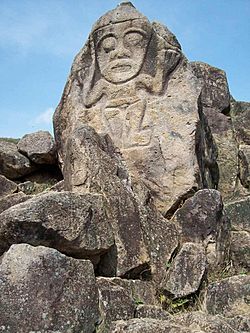
The San Agustín archaeological sites show some common features that stayed the same over different periods. This suggests that the different groups who lived there were related and had a long shared history. This is also seen in their pottery and stone tools, as well as in some of the designs on the sculptures. These ancient designs started at least in the 7th century BCE and continued, alongside newer ones, until the 16th century CE.
The sculptures show many animals linked to nature or farming. The sun, moon, lightning, rain, and other natural events are shown as people or creatures in the carvings. The gods often look like a mix of humans and animals and are closely connected to burial rituals. The sun and moon were the most important gods.
The frequent appearance of a feline (cat-like) mouth in most sculptures shows that they worshipped the jaguar. This seems to be one of the oldest and most widespread beliefs among people in the Andean mountains, and it still exists among native groups in the Amazon jungle today. Other ancient cultures in the Andes also show this jaguar feature in their sculptures.
The Mesitas Area
Most of the cultural activity in this whole region was focused around the Mesitas area. Many homes were also located here. The oldest dates found by scientists were also concentrated near Mesitas.
Many of the large sculptures are found here. Some are called caryatids because they are statues of warriors that seem to hold up the roofs of the large tombs in Mesitas A and B.
Similar large stone figures are found in other mounds at Mesitas. These statues show warriors in a realistic way, wearing special headwear and carrying weapons like rounded throwing stones and shields. In some statues, the shield is replaced by a short club, like the macuahuitl mentioned in old Spanish writings from the 16th century.
At a place called La Estación, archaeologists found a temple or ceremonial house from the Recent Period. It's the largest building structure found in the region, measuring 9 meters (about 30 feet) across.
What Did They Wear and Use for Jewelry?
Many of the human-like figures in the sculptures appear naked or with only light clothing and jewelry. This includes necklaces, bracelets, nose rings, and ear coverings. This is interesting because the San Agustín area has a mild climate, which gets cooler as you go up into the mountains. However, some sculptures show figures wearing kilts (skirt-like garments) and hats made from tree bark. Tools for spinning thread are rare in the archaeological findings. The jewelry found is varied: necklaces made of limestone and hard stone beads (some bluish-green and tubular), beads made of shell, seeds, bone, and gold. They also had gold nose rings (round, flat, or twisted wire, sometimes with horn or stone settings), solid gold earrings shaped like tiny eagles, gold headbands, and other ornaments. These match the jewelry seen on the statues.
What Was Their Pottery Like?
The pottery of the San Agustín culture was mostly one color, made in a hot oven with air, using a coiling method, and covered with different shades of reddish-brown clay. Most items were small bowls, plates, tripod pots (pots with three legs), or cups with tall bases. There were also large pots used for storing liquids or as funeral urns. The decorations were almost always carved into the clay. Sometimes they used a "negative painting" technique, where black designs were made on a red background. This was common in the early stages of the culture, known as the Superior Formative period. In the final period, or Recent period, they started using two-color painting and a grainy decoration.
|
See also
 In Spanish: Cultura San Agustín para niños
In Spanish: Cultura San Agustín para niños


